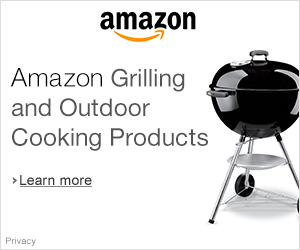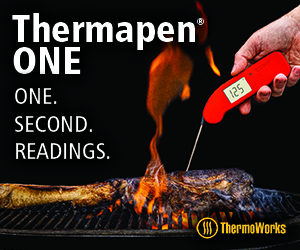Here are some of the common mistakes made by WSM owners while operating their cookers. Hopefully this topic will help you avoid some of these common pitfalls.
If you have a blunder you’re willing to fess up to, send me an email and I’ll consider adding it here. Thanks to lewjeff on The Virtual Weber Bulletin Board for suggesting this topic.
Hot Surfaces & Fuel
Wear Heat-Resistant Gloves When Handling The Cooker, A Chimney Starter, Hot Charcoal, And Cooking Grates
Even experienced WSM owners sometimes forget to wear heat-resistant gloves when handling a hot Weber chimney starter, hot cooker parts, or adjusting the bottom vents. Wear gloves at all times, just to be safe. Use tongs or other barbecue tools to adjust vents if not wearing gloves.
Use Caution When Handling Parts That Have Been Sitting Near A Heat Source
For example, the middle cooking section or a Weber chimney starter can get very hot while sitting next to a charcoal bowl full of red-hot coals. Again, wearing heat-resistant gloves is important.
Don’t Brush Up Against The Cooker
Folks have burned their arms, legs, and even faces by brushing up against a hot cooker. Not only should you use caution when working with a hot cooker, but also when engaged in recreational activities around it.
Wear Closed-Toe Shoes When Working With The Cooker
If you want a real “hot foot”, try dropping hot charcoal briquettes onto your toes while wearing flip flops or stepping on a hot coal while barefoot. Ouch!
Don’t Touch Hot Thermometer Probes, Rib Racks, Or Other Accessories
“When the thermometer reads 160°F, the probe is actually that temperature. Don’t touch it with your bare hands, it is hot!”
– Anne M, via email
Remember that instant-read thermometers, wired thermometer probes, rib racks, foil pans, tongs, skewers, or any other accessory that has been in contact with the heat of your Weber Bullet will be very hot. As stated before, using heat-resistant gloves is a must.
Hot Grease/Meat Juices
Use Caution When Handling Foil-Wrapped Meat
“Made a jumbo smoked Boston Butt, foiled during last few hours. When removing butt from smoker, the foil got a tear in it and scalding grease leaked out onto my bare shin bones. Stung pretty bad, went to clean myself up and the skin just melted away! Went to urgent care, got some 2nd degree burn treatment, then several days of serious wound care. Now I am WAY more careful with any wrapped meat chunk!”
– George N, via email
In addition to using heat-resistant gloves when handling foil-wrapped meat, it would be wise to wear pants to cover your legs and shoes to cover your feet. The reality, of course, is that we often barbecue in casual attire like shorts and flip-flops. So it’s important to pay attention and exercise caution when handling foil-wrapped meat. Pick it up carefully using both hand; look for tears in the foil and any leaks of hot liquid; avoid dragging the wrapped meat across surfaces that might tear the foil; replace foil or add an additional layer if torn mid-cook; and place foil-wrapped meat on a rimmed baking sheet pan when moving it or carrying it any distance.
Cooking Grate
Don’t Dump The Cooking Grate Into The Water Pan Or Charcoal Bowl
On rare occasions, a poor-fitting top cooking grate can shift and slip off the grill straps, causing the meat and grate to fall down into the water pan and/or charcoal bowl. Spilled pan contents may result in a super-hot burst of steam coming out of the cooker and can even cause a grease fire, potentially burning your hands, arms, and face.
Inspect the fit of the top cooking grate; if it doesn’t appear to be secure, see Parts Troubleshooting for a suggestion on how to adjust the grill straps with washers.
Place meat and remove meat carefully from the top cooking grate. Don’t drag meat across the grate, as this can cause the grate to shift. The grate is not a work surface—don’t truss, tie, trim, cut or otherwise work on the meat while on the grate. Perform these activities in the kitchen or off the cooker on a stable work surface.
Water Pan
Don’t Start A Grease Fire By Cooking With A Dirty Water Pan
Always cook with a clean water pan, especially when using an empty pan and cooking at high temperatures, as accumulated grease can cause a grease fire. A member of The Virtual Weber Bulletin Board reported that a grease fire like this occurred in his WSM with flames shooting 16 feet into the air and resulting in a melted lid handle and ruined thermometer probes.
Foil The Water Pan Properly
Improperly foiling the pan may cause water to wick up and over the edge of the pan and down into the charcoal, making a real mess in the bottom of the cooker. See Using A Water Pan In Weber Smokers for proper foiling techniques.
Don’t Place The Water Pan On The Charcoal Chamber
I got an email from a man who couldn’t get his cooker over 200°F. After several messages back and forth I realized that he was placing the water pan directly on top of the hot coals in the charcoal chamber. The pan was smothering the fire!
Make Sure The Water Pan Is Securely Seated In the Middle Cooking Section
“We were at a KCBS contest and using two 22 in. WSM’s. When it came time for the chicken, I dumped the pan with all the grease into the coals and started a fire. I had a glass of tea sitting next to me and I grabbed it and threw it on the fire, which of course made it worse and the fire burnt our 10×10 tent down in a second – everyone was coming over to check on us. We were all fine except my ego. Don’t know what I was thinking.”
– Doug Q, via email
Confirm that the water pan is properly seated on the grill straps before placing the middle cooking section over the hot coals. If the water pan doesn’t appear to be secure, see Parts Troubleshooting for a suggestion on how to adjust the grill straps with washers.
A water pan that is not properly seated can fall into the charcoal bowl, spilling water and grease into the fire. Spilled pan contents may result in a super-hot burst of steam coming out of the cooker and can even cause a grease fire, potentially burning your hands, arms, and face.
Don’t Put Your Face Or Hands Over A Hot, Empty Water Pan While Adding Water
To avoid the possibility of burns, add water immediately before the pan gets hot. Do not put your face directly over the pan. Stand back from the cooker and wear long barbecue gloves to protect your arms.
Don’t Overfill The Water Pan. Don’t Bump Or Move The Cooker During Use.
When filling the pan before or during cooking, be careful to not overfill the pan. Do not bump or move the cooker during use and do not attempt to remove the water pan while cooking.
Remember, fat floats on top of water, so if you bump or overfill the pan, the first thing to hit the fire is grease.
In addition to the issue of personal safety, from a cooking standpoint, spilling pan contents into the fire isn’t such a good idea, either. Your fire will be extinguished, your meat will be covered in ashes, and your cooker will be an absolute mess inside. There’s even an acronym for this: STUPID BOYS (Spill The Unfastened Pan Into Da Bottom Of Your Smoker).
If a grease fire starts inside the cooker, extinguish the flames by replacing the lid and closing all the vents. If you attempt to remove the water pan during cooking and find yourself holding a pan of flaming grease, do not take the pan indoors and do not try to extinguish the flames using water. Set the pan down in a safe location and extinguish it by placing the WSM lid over the pan, or use baking soda or a fire extinguisher put out the fire.
Don’t Forget To Replace The Lid And Close The Vents After Cooking
The contents of the water pan will begin to boil and burn if you leave the lid off after cooking. Not only does this smell really bad, but it might cause a grease fire in the pan.
Charcoal Chamber
Don’t Dump Hot Coals Into The Cooker Without The Charcoal Chamber In Place
It’s not much fun trying to fit the chamber over a bunch of hot, loose coals scattered over the charcoal grate. Make this mistake once and you’ll get in the habit of putting the chamber in place before lighting your chimney starter.
Access Door
Make Sure The Access Door Is Properly Latched
“I added a few chunks of smoke wood and replaced the door. I checked the cooker 30 minutes later. The door was laying on the ground and the cooker was running 350°F.”
– Anonymous
Make sure that door is latched securely!
Lid
Don’t Peek At The Meat While Cooking
You don’t help the cooking process by removing the lid every 15 minutes to check on the meat. The only reason to remove the lid of the WSM while cooking is to add, remove, turn, rotate, baste, or mop the meat.
Don’t Put The Lid Down Directly On A Deck Or Patio
Want to leave a big, oily circle on your beautiful wooden deck or patio? No, of course you don’t. Go to the auto supply store and buy the largest automobile oil drip pan you can find. Place this pan under your WSM during use. It will catch any drips from the cooker with room to spare for the lid when removed. The pan cleans easily with a little soap and water. Patio saved, problem solved.
Don’t Put The Lid Down On A Dirty Surface
The oily edge of the lid will grab dirt, grass, leaves, or anything else it comes into contact with. You don’t want that stuff near your food. Get that automobile oil drip pan I just told you about.
Don’t Remove The Lid Thinking It Will Reduce The Cooker Temperature
Removing the lid lets a ton of oxygen into the cooker for combustion, which can cause the cooker temperature to get even hotter. Be patient and close the bottom vents for temperature control, and close the top vent partially only as a last resort. See Temperature Control Problems: Too Hot, Too Cool for more details.
Don’t Forget To Wipe The Edge Of The Lid After Cooking To Prevent A Sticking Lid
While the cooker is still warm, use a paper towel to wipe off any grease from the edge of the lid and from the lip on the middle cooking section where the lid rests. This prevents the lid from becoming stuck to the middle cooking section as the grease cools.
Here’s a video that discusses how to fix and prevent sticking lids.
Wind Screen
When Using A Wind Screen, Make Sure It Is Securely Weighted Down Or Staked To The Ground
“I made a wind screen to protect my WSM from high winds during cooking. One day I heard a loud crash outside and found that the screen blew down and knocked over the WSM. The smoke wood and charcoal caught fire and were igniting the wind screen. The access door was a contorted mess. A pork butt was laying on the driveway while another was inside the lid.”
– Anonymous
By the way, you should always have a fire extinguisher handy while barbecuing.






